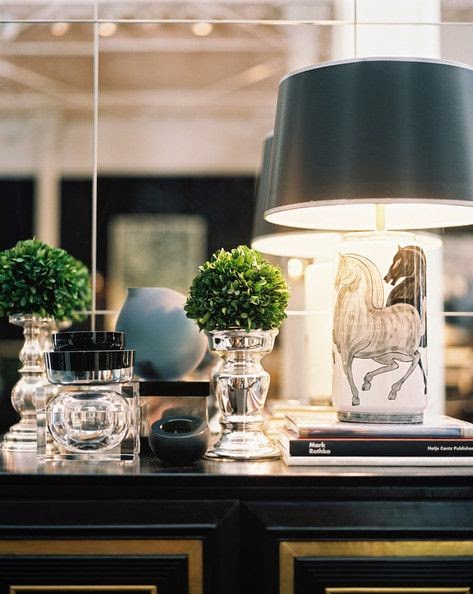The Decorating Psychologist: A Tale for Designers and Our Clients
joy of nesting
ANNA SPENCER PHOTOGRAPHY above
Going
into client’s homes on a regular basis, I obviously encounter a lot of decorating
and design problems. Often the homeowner has made poor remodeling choices, or
has purchased the wrong sofa or color of paint or carpet and calls me to solve
their problem.
Going
into client’s homes on a regular basis, I obviously encounter a lot of decorating
and design problems. Often the homeowner has made poor remodeling choices, or
has purchased the wrong sofa or color of paint or carpet and calls me to solve
their problem.
CAROLYN ROEHM above
It’s
not a fun spot for either of us to be in because by this time the client is
frustrated from spending too much time and money on a project that hasn’t
delivered the satisfaction they’d hoped for. Their dreams (yes dreams, it’s a
heady business) are dashed because they anticipated a happy outcome and
instead, have to live with a less-than-ideal reminder on a daily basis.
FRANCES PALMER POTTERY above
It’s
a challenge at this point because now I’m not just wearing my designer hat, I
also have to don the heavy hat of psychologist. And though I might be up to the
task of fixing the design related problem, it’s disappointing for me if I’m
unable to change that person’s state of mind too.
a challenge at this point because now I’m not just wearing my designer hat, I
also have to don the heavy hat of psychologist. And though I might be up to the
task of fixing the design related problem, it’s disappointing for me if I’m
unable to change that person’s state of mind too.
from LONNY, above
The
American consumer has high expectations. Recently a client
asked for my assistance with redecorating her living room and dining room. She
needed all her furniture recovered, new window treatments, new dining room
chairs, and pillows. I was to work around her existing paint, accessories, drapery
hardware and antiques. It appeared to be an easy job except that the budget was
unusually small. I put together two separate design
schemes of fabrics, floor plans, and budgets. I came very close to the budget
she had requested and even offered to do the work in stages.
American consumer has high expectations. Recently a client
asked for my assistance with redecorating her living room and dining room. She
needed all her furniture recovered, new window treatments, new dining room
chairs, and pillows. I was to work around her existing paint, accessories, drapery
hardware and antiques. It appeared to be an easy job except that the budget was
unusually small. I put together two separate design
schemes of fabrics, floor plans, and budgets. I came very close to the budget
she had requested and even offered to do the work in stages.
from HOUZZ, above
The
day of her presentation I arrived at her home with two CAD floor plans, twenty some fabric swatches put into two distinct color schemes, sketches, full
estimates for each item to be covered or fabricated, two written purchasing time lines, and two separate budgets– one
at the budget she’d requested and one, more realistic, slightly larger budget.
day of her presentation I arrived at her home with two CAD floor plans, twenty some fabric swatches put into two distinct color schemes, sketches, full
estimates for each item to be covered or fabricated, two written purchasing time lines, and two separate budgets– one
at the budget she’d requested and one, more realistic, slightly larger budget.
The client
liked the fabric selections but felt they weren’t exactly what she was looking
for. Further, she was emphatic that she would purchase my fabrics at wholesale
and assign me to oversee the more difficult task of fabrication. Unfortunately,
most designers don’t work that way because the liabilities outweigh the
commissions we receive on the labor portion of the transaction. In other words,
commission on labor/fabrication is low and the commission from fabrics is
needed to make it worthwhile. As well, fabric companies won’t sell at wholesale
prices to non-designers. I would have to purchase the fabric for her (again
assuming potential liability on the fabric) and give her my wholesale pricing.
liked the fabric selections but felt they weren’t exactly what she was looking
for. Further, she was emphatic that she would purchase my fabrics at wholesale
and assign me to oversee the more difficult task of fabrication. Unfortunately,
most designers don’t work that way because the liabilities outweigh the
commissions we receive on the labor portion of the transaction. In other words,
commission on labor/fabrication is low and the commission from fabrics is
needed to make it worthwhile. As well, fabric companies won’t sell at wholesale
prices to non-designers. I would have to purchase the fabric for her (again
assuming potential liability on the fabric) and give her my wholesale pricing.
So
getting back to the fabric selections. As I said, she liked them but they
weren’t quite what she was hoping for. She was disappointed and I felt awful. I
wanted her to be happy with my services so I offered to do two more design
schemes, gratis.
getting back to the fabric selections. As I said, she liked them but they
weren’t quite what she was hoping for. She was disappointed and I felt awful. I
wanted her to be happy with my services so I offered to do two more design
schemes, gratis.
A few weeks later I went back to her home with all new fabrics (a four hour round trip) but the new
schemes were met with the same response. She liked them but they weren’t
exactly what she was looking for. I drove to her home a third time, this time
charging her one hour’s design time, and brought with me two big bags of fabric
swatches. We sat there on her sofa for an hour while I put together five more
design schemes in front of her. Though these fabric schemes were really lovely,
again we had no success.
schemes were met with the same response. She liked them but they weren’t
exactly what she was looking for. I drove to her home a third time, this time
charging her one hour’s design time, and brought with me two big bags of fabric
swatches. We sat there on her sofa for an hour while I put together five more
design schemes in front of her. Though these fabric schemes were really lovely,
again we had no success.
As
a last resort, we agreed to meet at the San Francisco Design Center and spend
two hours looking at fabrics. Again, I charged her only one hour and was
certain this would solve the problem. For the record, I don’t normally do this.
Most people like my fabrics. I arrived twenty minutes early having allowed for
San Francisco Bay Bridge traffic. Unfortunately, the client arrived thirty to
forty minutes late and was visibly upset about it.
a last resort, we agreed to meet at the San Francisco Design Center and spend
two hours looking at fabrics. Again, I charged her only one hour and was
certain this would solve the problem. For the record, I don’t normally do this.
Most people like my fabrics. I arrived twenty minutes early having allowed for
San Francisco Bay Bridge traffic. Unfortunately, the client arrived thirty to
forty minutes late and was visibly upset about it.
from LONNY, above
The day was off to a bad start for her. None of
my cajoling would remedy her mood. Of the two large fabric showrooms we
scoured, none of the fabrics would do. She left feeling angry and defeated. In
this type of situation, there’s nothing you can do to make it right for the
client. I was crushed that my extra efforts were not only unhelpful but also
unappreciated. After two more efforts via phone, I received a curt note with her final
payment, saying among other things that she would not be proceeding with the
project.
my cajoling would remedy her mood. Of the two large fabric showrooms we
scoured, none of the fabrics would do. She left feeling angry and defeated. In
this type of situation, there’s nothing you can do to make it right for the
client. I was crushed that my extra efforts were not only unhelpful but also
unappreciated. After two more efforts via phone, I received a curt note with her final
payment, saying among other things that she would not be proceeding with the
project.
MARK D. SIKES above
It’s
hard not to take those types of disappointments personally. She was my “charge”
and I felt responsible for her disappointment. Looking at it with a few months
perspective, I understand there was more going on with her than fabrics. Still I
felt let down.
hard not to take those types of disappointments personally. She was my “charge”
and I felt responsible for her disappointment. Looking at it with a few months
perspective, I understand there was more going on with her than fabrics. Still I
felt let down.
Fortunately,
95% of my clients are absolute gems. I feel I’m able to be of service to them.
They are for the most part happy individuals, retired, living in beautiful
homes, with low stress lifestyles. I love serving people who appreciate what I
bring to their projects. We form personal relationships and some of my best
friends today were clients ten or so years ago.
95% of my clients are absolute gems. I feel I’m able to be of service to them.
They are for the most part happy individuals, retired, living in beautiful
homes, with low stress lifestyles. I love serving people who appreciate what I
bring to their projects. We form personal relationships and some of my best
friends today were clients ten or so years ago.
To
avoid unrealistic expectations and create a successful design project that
satisfies your own unique set of requirements, follow a few of my simple guidelines below. With or without a designer, keep these in mind as
you embark on your projects to save yourself from potential
disappointments like the client above.
avoid unrealistic expectations and create a successful design project that
satisfies your own unique set of requirements, follow a few of my simple guidelines below. With or without a designer, keep these in mind as
you embark on your projects to save yourself from potential
disappointments like the client above.
Shiree’s Cheat Sheet
· First and
foremost, get clarity on what you can realistically accomplish, both
financially and logistically. Set out a budget and buying plan by prioritizing
what is most important. That way, you can defer the less important items till a
later date.
foremost, get clarity on what you can realistically accomplish, both
financially and logistically. Set out a budget and buying plan by prioritizing
what is most important. That way, you can defer the less important items till a
later date.
·
If you don’t
already have a defined style you can start by reading magazines like HouseBeautiful, Elle Décor, and Architectural Digest to gain some insight into your
own taste. Or go to designer showcases such as the ones in San Francisco every
spring. Save a picture file on ideas you particularly like.
If you don’t
already have a defined style you can start by reading magazines like HouseBeautiful, Elle Décor, and Architectural Digest to gain some insight into your
own taste. Or go to designer showcases such as the ones in San Francisco every
spring. Save a picture file on ideas you particularly like.
· Realize that your
purchases are not going to make your life wonderful if it’s not already so.
Design is meant to “enhance” an already happy life.
purchases are not going to make your life wonderful if it’s not already so.
Design is meant to “enhance” an already happy life.
· Designers can only modify their pricing so far. There
are overhead and liability issues and many unforeseen contingencies. It’s not a
simple job.
are overhead and liability issues and many unforeseen contingencies. It’s not a
simple job.
· Use qualified individuals
for fabrications. Get word of mouth recommendations and whenever
possible see their work in person or via their portfolio.
for fabrications. Get word of mouth recommendations and whenever
possible see their work in person or via their portfolio.
·
DIY’ers, start a three ring binder
with divider pages. Create tabs such as “List of Priorities”, “Receipts”, “Magazine
Clippings”, “Drafts”, “Fabric Swatches”, “Work Orders”, and “Contracts”.
DIY’ers, start a three ring binder
with divider pages. Create tabs such as “List of Priorities”, “Receipts”, “Magazine
Clippings”, “Drafts”, “Fabric Swatches”, “Work Orders”, and “Contracts”.
· Take “before” photographs of your
projects. Photographs show obvious areas in need of improvements more clearly
than seeing a room in person. Take “after” shots and revel in your success.
projects. Photographs show obvious areas in need of improvements more clearly
than seeing a room in person. Take “after” shots and revel in your success.










